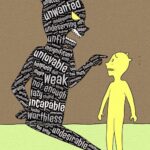This is the latest installment of articles on toxic shame. I have been focusing on shame and the role it plays in emotional suffering for several reasons.
First, it is a central experience in childhood for many who have suffered traumatic attachment wounds. Whether the shame remains fully conscious or gets locked away from awareness, it exerts a profound impact on one’s life.
Second, shame is often at the center of different psychiatric conditions, from depression to C-PTSD to numerous personality disorders, and for healing of these conditions to occur, shame must be dealt with.
And lastly, shame can be a hidden force in addictions, certain patterns of infidelity and the creation of a secretive life where acting out predominates.
For these reasons, it’s important to examine the different causes of toxic shame and the complex ways it manifests throughout one’s life.
~~~
The attachment wounds inflicted by childhood mistreatment, abuse, and neglect bear the indelible mark of humiliation. In these distressing moments, individuals are subjected to feeling a profound sense of insignificance, with words like “belittled” and “demeaned” used to capture the subjective essence of humiliation.
Klein (1991) underscores the experience, noting it involves “some form of ridicule, scorn, contempt, or other degrading treatment at the hands of others.” Additionally, traumatic humiliation is frequently accompanied by an acute sense of injustice and powerlessness, further intensifying the traumatizing effects of the abuse.
When someone is humiliated by being violated or betrayed, it’s normal to feel angry, especially towards the person who caused the harm. But for people who have experienced abuse, it’s often not safe to show this anger because it might make the situation worse. So instead of expressing it outwardly, that anger gets turned inside, leading to what we call toxic shame. This happens when the anger, instead of being directed at the person who hurt you, takes the form of self-attack, negatively affecting how you see yourself and making you feel highly critical about who you are.
Toxic shame arises from the belief that one is responsible for the mistreatment they endured. For example: “I bear the blame for what happened to me” or “I am inherently flawed and broken due to my past experiences.” In this context, the traumatized child internalizes a sense of responsibility for what has occurred, perceiving the cause of the abuse as either originating from or reflecting an intrinsically tainted self.
~~~
After taking root, toxic shame frequently persists well beyond the actual abusive events that initially gave rise to it, influencing one’s self-perception in enduring and profound ways.
After taking root, toxic shame frequently persists well beyond the actual abusive events that initially gave rise to it, influencing one’s self-perception in enduring and profound ways. The tenacity of toxic shame feeds the belief that at our core, we are fundamentally flawed, undeserving of love, acceptance and belonging.
Now we will delve into various manifestations of shame, examining how it shapes and detrimentally influences multiple dimensions of one’s life.
Toxic Shame and Its Impact on Deservingness
The Erosion of Self-Worth
Toxic shame is a corrosive force; it can erode the very foundation of one’s self-worth, leaving an individual grappling with a sense of undeservingness and inadequacy. This internalized belief that one is inherently less-than can infiltrate various aspects of life, from personal relationships to professional pursuits.
Research indicates that individuals burdened by toxic shame may struggle with imposter syndrome, constantly questioning their worthiness of success and love. The insidious nature of shame creates a barrier to embracing the inherent value and deservingness that is every individual’s birthright.
This erosion of self-worth leads one to expect very little in life. It is believed that good fortune is reserved for others, and when it does happen to occur for the individuals dealing with toxic shame, it is often minimized or seen as a fluke. Therefore, the positive occurrence doesn’t add much (if any) meaning to life.
The corrosion of self-worth by toxic shame can also give rise to incapacitating self-doubt. This manifests as a persistent pattern of relentless questioning and second-guessing. The desperate pursuit of assurance often fails to counteract the skepticism instilled by toxic shame, perpetuating a cycle of self-doubt that significantly hampers personal and professional growth (and any sense of fulfillment for one’s achievements).
The Shackles of External Validation
While managing toxic shame, external validation can offer a momentary reprieve from the ceaseless onslaught of the inner critic. Yet this reliance on external sources for validation can evolve into an insatiable need for approval, a desperate attempt to offset the lingering feelings of inadequacy. The continuous quest for affirmation from others becomes a precarious foundation upon which self-esteem is balanced, susceptible to the fluctuations of external opinions and judgments.
This over-reliance on external validation not only places one’s sense of self-worth at the mercy of others, but also perpetuates a cycle of dependency that hinders authentic self-discovery and growth. The fleeting moments of reassurance obtained through external approval provide only a superficial salve, incapable of addressing the root causes of toxic shame.
Consequently, the external pursuit of others to heal what is amiss can lead to a persistent sense of emptiness and unfulfillment. These relational patterns may culminate in chronic frustration and resentment towards those incapable of alleviating the enduring pain caused by toxic shame.
Shame’s Impact on Intimacy and Connection
Toxic shame casts a long shadow over intimate relationships, obstructing the path to emotional openness and connection. The fear of being vulnerable, of being seen and judged for perceived flaws, prompts individuals to hide — whether through withdrawing physically or emotionally, or through the construction of a secretive life.
These patterns of avoidance feel urgently necessary, a survival reaction to the perceived threat of further humiliation.
Paradoxically, the act of withdrawal, initially aimed at self-protection, frequently becomes its own source of pain, deepening a sense of loneliness and compounding the layers of shame. The retreat into secrecy, while momentarily offering a respite from potential judgment, intensifies the isolation, perpetuating a self-reinforcing cycle of disconnection and feelings of unworthiness.
It’s important to highlight that the interpersonal withdrawal driven by toxic shame is often experienced as necessary, fueled by the belief that living in the shadows is essential for safety.
Prioritizing the management of further (potential) humiliation and retraumatization becomes the immediate task at hand, even if it means resorting to self-destructive and other-destructive behaviors in the process.
The dread of revealing one’s true self triggers survival reactions of fight, flight or freeze. Prioritizing the management of further (potential) humiliation and retraumatization becomes the immediate task at hand, even if it means resorting to self-destructive and other-destructive behaviors in the process.
Toxic Shame as a Barrier to Needs and Desires
Alienation from Self
Often the inner critic perpetuates our own shame, making us feel less-than, incapable or unlovable.
Why would we do this to ourselves? Have we taken on the internalized roles of abuser and abused from our past in ways that simply repeat the abuse?
It’s important to understand the intent of our inner critic (Sweezy, 2023), since this seemingly hostile part of us is actually trying to protect us in the only way it knows how. On the surface, the inner critic appears sadistic and cruel, criticizing us at every turn, especially when we pursue what is important to us. But there is much more to this inner dictator.
Typically, the inner critic hates it whenever we make ourselves vulnerable. The inner critic believes safety lies in this simple equation: vulnerability = danger. If the inner critic’s intent was transcribed, it might read something like:
“You were vulnerable and dependent as a child. You couldn’t protect yourself, and you paid the price by being mistreated, abused, bullied, etc. So I’m going to make sure you don’t put yourself out there and open yourself up to further injury. Every time you act on your wants and desires, you are setting yourself up for an enormous letdown, for further rejection, humiliation and/or abuse. So I will preemptively stop you; I will flatten you before others and the world do that to you again…”
This form of protection, however, comes at a cost. The inner critic attacks the parts of us that want and desire. Whenever needs arise, the looming prospect of falling short, facing disappointment, or enduring rejection arises. While it is acknowledged that disappointment and rejection are aspects of the human experience, the inner critic anticipates that their impact will land with a seismic intensity.
This heightened reaction is fueled by the possibility that these rejections will resonate deeply within the younger, traumatized parts of ourselves, rekindling the dormant pain they hold. The impending flooding of emotions holds the potential to unravel the delicate balance of self-preservation that the inner critic seeks to maintain, ultimately influencing our choices and behaviors by suppressing our longings and desires (for connection, achievement, intimacy, play, fulfillment…)
As this inner critic banishes the vulnerable parts of us that crave connection, fulfillment, and love, a profound disconnection from our authentic self unfolds. We become alienated from vital parts of ourself.
The Silencing Effect of Toxic Shame
Shame functions as a silencer, muffling the voice of one’s hopes and dreams. The capacity for experiencing positive emotion (like spontaneity, joy, creativity and playfulness) is often a casualty of toxic shame. The anticipation of harsh repercussions such as judgment and rejection prevents individuals from pursuing what they truly want.
The inner critic, having learned to associate self-expression with peril, actively discourages the pursuit of one’s authentic longings. The silencing effect of toxic shame can make our own yearnings unrecognizable to us. We become silenced because when we are cut off from our inner world in this way, we no longer know what it is that we want.
As the inner critic’s voice gets louder, it shuts out and silences the many voices within us that desperately want to be heard and witnessed.
In abusive families, wanting and spontaneous self-expressions are dangerous for the child. In this regard, the self that wants and needs is now the threat that requires handling. And while managing this threat, we lose access to the deepest parts of us that need our attention and healing. As the inner critic’s voice gets louder, it shuts out and silences the many voices within us that desperately want to be heard and witnessed.
Paradoxically, the “solution” of this inner silencing, at some point, becomes the very problem that hinders our self-discovery and healing.
Compulsive Expression of Suppressed Needs
The repression of desire and wanting by toxic shame can give rise to a pressure cooker effect, where unexpressed wants and needs build up until they find release in unhealthy, compulsive ways. Whether through addictive behaviors, impulsivity, self-sabotage, infidelity or other forms of acting out, these expressions become distorted manifestations of suppressed desires.
The wounded fragments of ourselves, often relegated to an inner basement by the shaming inner critic, may remain concealed from conscious awareness. However, make no mistake, these exiled parts exert a potent influence on our actions and reactions. They will look for openings and seek expression when opportunities arise (e.g., when we are overwhelmed or stressed), and in doing so derail our conscious intentions.
When seeking to comprehend what appears on the surface to be self-sabotaging behaviors that conflict with one’s core values, it becomes paramount to unravel the intricate connection between shame, the suppressed desires of these wounded, exiled parts, and the compulsive expressions that inevitably ensue.
When seeking to comprehend what appears on the surface to be self-sabotaging behaviors that conflict with one’s core values, it becomes paramount to unravel the intricate connection between shame, the suppressed desires of these wounded, exiled parts, and the compulsive expressions that inevitably ensue.
~~~
In the face of toxic shame and the relentless inner attacks that are part of the internal shame dynamic, there exists an innate desire within all of us to heal, grow, and live authentically. This life-force may get obscured and stifled by these contemptuous, shaming parts, but this inherent desire to heal and become whole is always present, waiting for us to access it.
Understanding this complex interplay of protective and wounded parts helps shed light on behaviors that contradict our values and beliefs — behaviors that are often influenced by the lingering, unhealed wounds of the past. While these wounds may have been formed long ago, the humiliation and shame caused by childhood abuse often exist in the present, impacting us in complex ways.
Recognizing the ongoing influence of toxic shame is crucial to unraveling the complexities behind bewildering, destructive actions and offers insight into the unresolved traumas that shape one’s life.
~~~
Rich Nicastro, PhD is a clinical psychologist based in Austin, Texas. He has over twenty-five years of experience working with individuals and couples. He offers teletherapy to clients throughout the United States.
~~~
Article References:
Elshout, M., Nelissen, R. M., and Van Beest, I. (2017). Conceptualizing Humiliation. Cognition and Emotional, Vol 31, No. 8, 1581-1594.
Klein, D.C. (1991) The humiliation dynamic: An Overview. The Journal of Primary Prevention, 12, 93-121.
Shaw, D. (2023). Shame and Self-Alienation: A Trauma-Informed Psychoanalytic Perspective. Psychoanalytic Inquiry. 1-12.
Sweezy, M. (2023). Internal Family Systems Therapy for Shame and Guilt. The Guilford Press.





